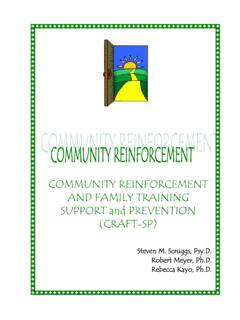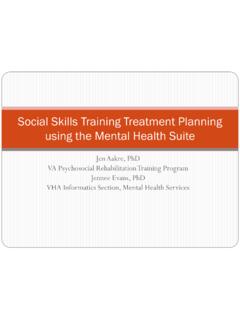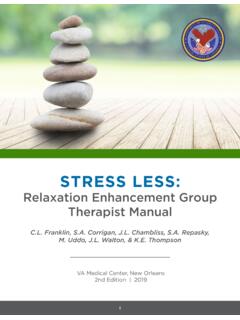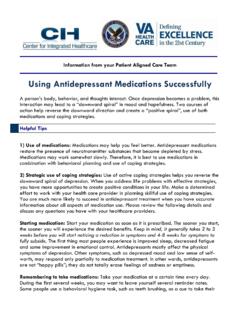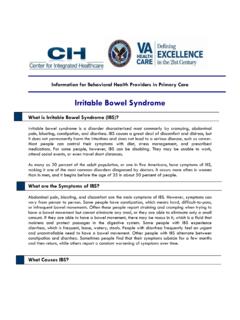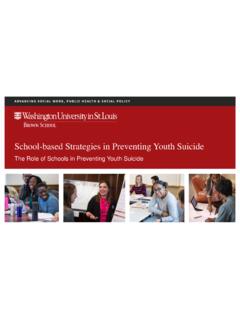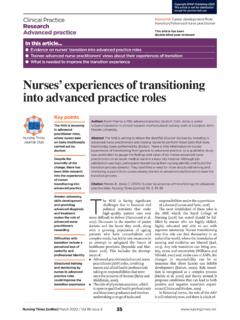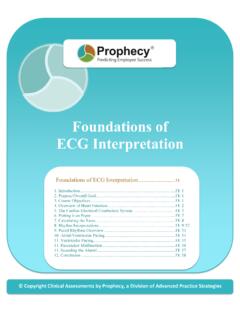Transcription of Treatment Interventions for Suicide Prevention
1 Kate Comtois, PhD, MPHU niversity of WashingtonTreatment Interventions for Suicide PreventionSuicide Prevention has many formsPublic health or injury preventionGatekeeper TrainingTreating DepressionSuicide Prevention has many formsThis talkis about preventing Suicide with mental health Interventions to treat Suicide attempts or other suicidal behaviorOverview What does the clinical trial research tell us about Treatment with suicidal patients? What doesn t work? What does work? What can we learn clinically from the research data?
2 What doesn t have evidence?Inpatient psychiatric et al, 2009, Deliberate Self HarmNote, highest risk individuals excluded from type of inpatient et al, 2009, Deliberate Self HarmEasy access to inpatient psychiatry has promise, but is not et al, 2009, Deliberate Self HarmAnti-depressant medications don t have evidence et al, 2009, Deliberate Self HarmWhat does work?Earlier studies of CBT show (Meta-analysis including DBT show significance for CBT)Cognitive Therapy for Suicide Prevention (10-16 sessions) plus case management is quite effective in reducing Suicide , G.
3 K. et al. JAMA 2005;294:563-570 Dialectical Behavior Therapy (DBT) is effective at reducing self harm (with BPD). et al, 2009, Deliberate Self HarmSince this review, DBT benefits have been replicated in 8 randomized clinical trials. Two trials non-significant: compared to APA guidelines for BPD and to Transference Focused TherapyAnd, believe it or not, an innovative idea from 1976: sending caring letters is were sent to patients who were not in Treatment 30 days after inpatient Year Psychiatric Hospital admissions010020030040050060070080012345 67891011121314151617181920 QuarterCumulative nControlPostcardSending caring letters was replicated in Australia for deliberate self half of the patients discharged after self-poisoning got these.
4 0 100 200 300 400 500 600 1 3 5 7 9 11 13 15 17 19 21 23 25 27 29 31 33 35 37 39 41 43 45 47 49 51 53 55 57 59 Cumulative number of readmissions Control Postcard 5 year medical admissions for self-poisoningCarter GL et al 2005 BMJ;331:805; Carter GL et al 2007 Br J Psychiatry;191 GL Oct 2008 Presentation at HMCR ecently letters did not replicate in psychiatric emergency room setting when controlling self-harmBeautrais et al 2010 Br J Psychiatry 197, 55 60 Caring letters receiving further study with study pending in Army personnel and revising a grant from Harborview to NIMH.
5 VA has implemented caring letters , 2006 Standard clinical interactions, including Suicide Interventions , are clinician as expert interviewing patient about MODELREDUCTIONISTIC MODELDEPRESSIONDEPRESSIONLACK OF SLEEPLACK OF SLEEPPOOR APPETITEPOOR APPETITEANHEDONIA ..ANHEDONIA ..? SUICIDALITY ?? SUICIDALITY ?(1)Treating Suicide directly (not just bytreating the diagnosis)Effective psychotherapies for suicidal individuals have (at least) 2 differences.(2) Using an overtly collaborative stance rather than psychiatric of psychiatric diagnosis does not necessarilyresult in reduction of Suicide risk.
6 Treatment associated with reduced psychiatric symptoms and suicidal behavior: Lithium in bipolar affective disorder (no RCT but Baldessarini et al, 1999 shows evidence in review of studies) (RCT in progress) Clozapine in schizophrenia (one RCT: Meltzer et al., 1998) Treatment notassociated with reduced psychiatric symptoms and suicidal behavior: Depression (Brent et al, 1997; Hawton et al, 2009; Khan et al., 2000; Khan et al, 2001; Lerner & Clum, 1990; Rutz, 1999) Psychosis (Khan et al., 2001) Depression in Borderline Personality Disorder (Linehan et al, 1991)If you re not treating diagnosis,what should you treat?
7 There are many stressors, including psychiatric diagnosis, experienced by suicidal drivers of suicidalityPain and Medical problemsHomelessnessFinancial StressInterpersonal conflict or lossThe most effective treatments focus on the unique problems of suicidal people that prevent them from solving secondary drivers of suicidalityIntense emotion dysregulationInability to solve problemsReasons for dying ( , thinking they are a burden)Lack of reasons for livingPsychiatric interviews often do not create collaboration.
8 Instead, the patient is more likely to feel interrogated (or even shamed if regretful). The patient may feel that you are only trying to run through a checklist, rather than trying to understand what is really going on. Patients are frequently aware that they can have their freedom taken away due to their Suicide risk, so they can be leery of , 2007 Collaborative Assessment and Management of Suicidality(CAMS)Take steps to overtly demonstrate a desire to be CAMS APPROACHTHE CAMS APPROACHTHERAPIST & PATIENTTHERAPIST & PATIENTSUICIDALITYSUICIDALITYP AINP AINSTRESSSTRESSAGITATIONAGITATIONHOPELES SNESSHOPELESSNESSSELFSELF--HAT EHAT EREASONS FOR LIVING VS.
9 REASONS FOR DYINGREASONS FOR LIVING VS. REASONS FOR DYINGMoodCollaborative Stance in CAMS Want to directly demonstrate to client that you empathize with the patient s suicidal wish You have everything to gain and nothing to lose from participating in this potentially life-saving Treatment . You can always kill yourself later. At the same time, clarify when you would have to take action that they might not choose know your personal and clinic limits If they won t participate in If they say they can t control their by Clinician (N=50)Assessor Screen (N=50)Accepted into Study (N=41)Randomization Sample (N=32)Rejected at Screening (N=9) leaving the country = 1 currently had provider = 3 denied SI = 4 wanted different Treatment = 1 CAMS(N=14)TAU(N=15)Completed Treatment (N=10)Dropped Study Treatment (N=2)
10 Dropped out of Study Assessments(N=0)Completed Treatment (N=12)Did not attend first session (N=9)Dropped Study Treatment (N=5)Dropped out of Study Assessments(N=3)Harborview CAMSF easibility TrialConsort ChartWithdrawn from study (N=3) too severe forstudy tx= 2 CAMS court-ordered to Treatment =1 TAUR esults for Suicidal IdeationBayesian Poisson HLM(because many zeros)Posterior mean= CI: - on Overall Symptom DistressStandard HLMt= p= SatisfactionAverage client satisfaction was high for both treatments (range 1-4).
